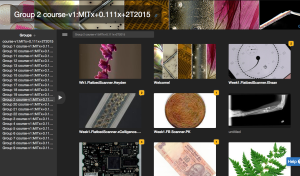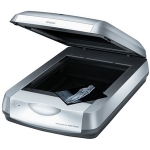Our online course, Making Science and Engineering Pictures, has just wrapped up week 1 and we are rolling into week 2 (of 6 weeks total). Week 1 marks the first photographic assignment: choose a small object (3-10 cm) and create an image of your object using a flatbed scanner. It’s a great way to begin a course like this, designed to encourage creative thinking about visual representations, because most people don’t think of a scanner as a photographic device. We encouraged the students to experiment with different backgrounds, different resolutions, or with the scanner cover on/off.
And the students did not disappoint. Examples of their creativity start with the amazingly eclectic range of objects selected – clothespins, currency, dismembered iPods and chargers, moss, flowers, agate, shells, soil samples, watch parts, cut fruit, beads, pine cones, fishing lures, flashing headlamps – you name it! Since many of our students are scientists or engineers, they are photographing the devices used in their research – microfluidic devices, electrode holders, circuit boards, magnets, silica gel, and experimental set ups. Their backgrounds were also quite clever – cleaning cloths, woven mats, paper, felt, lab tape, box tops, marble, and even chem wipes. The images are terrific – as rich and varied as the students enrolled in the course.
We opted to use VoiceThread as our image-sharing environment. Students link out to VT from the edX platform and are automatically and randomly sorted into small groups of 30. There they create a VT by uploading their images and commenting on them (in text, voice, or using their videocam). VoiceThread includes a drawing tools feature that allows you to sketch on the image, while commenting, to point out particularly interesting features.
Here’s a short video showcasing our students’ creativity:
The assignment includes the charge to comment on the VTs of others in your group, guided by a rubric provided in the assignment. When it works well, each student receives a few comments that might include questions or requests for clarifications (“what’s the resolution?”, ” how did you get that shadow effect?”). On the whole, the students’ comments have exceeded our expectations, going well beyond simple praise to asking questions (“was it worth scanning at such a high DPI?”), making suggestions (“what if you tried taking the image with two of them, side by side?”), and pointing out opportunities for further exploration.
I really enjoy listening to the students’ narration of their work. The many accents (our course includes students from 133 countries around the world) and the technical language they use, revealing their professional and academic backgrounds. I’m struck by the clever ways they use the technology to amplify their posts. For example, one student recorded his narration using his videocam, holding the photographed device in his hand, and demonstrated for us (in a macro sense) how he oriented the device on the scanner bed.
Of course there are technical issues (aren’t there always?) – students sorted into multiple groups, not remembering to comment, failing to name their VT in a way to make it easy to find. But, on the whole, it’s really working remarkably well. To date we have over 100 VTs in our class group – each one a rich and meaningful exploration of their images.



A grand learning experiment for all involved! Interesting to track and learn as an observer too. (Not sure your video link came thru…)
Pingback: Production Notes: Insight Into Building an Effective Online Course | Stepping Stones